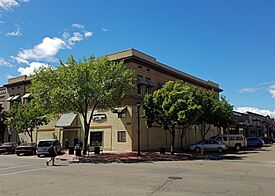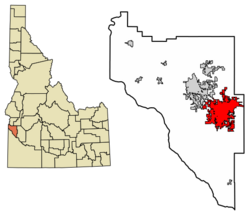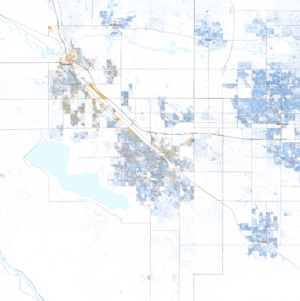Nampa, Idaho facts for kids
Quick facts for kids
Nampa
|
|
|---|---|

The former Nampa Department Store in Downtown Nampa
|
|
| Nickname(s):
The Heart of the Treasure Valley
|
|
| Motto(s):
What a Place to Live
|
|

Location of Nampa in Canyon County, Idaho
|
|
| Country | United States |
| State | Idaho |
| County | Canyon |
| Founded | September 8, 1886 |
| Incorporated | April 17, 1891 |
| Area | |
| • City | 34.77 sq mi (90.06 km2) |
| • Land | 33.48 sq mi (86.72 km2) |
| • Water | 0.15 sq mi (0.39 km2) |
| Elevation | 2,474 ft (754 m) |
| Population
(2020)
|
|
| • City | 100,200 |
| • Estimate
(2022)
|
110,951 |
| • Rank | US: 279th ID: 3rd |
| • Density | 2,992.7/sq mi (1,155.5/km2) |
| • Urban | 177,561 (US: 203rd) |
| • Metro | 811,336 (US: 75th) |
| • Combined | 899,574 (US: 67th) |
| Demonym(s) | Nampon |
| Time zone | UTC–7 (Mountain (MST)) |
| • Summer (DST) | UTC–6 (MDT) |
| ZIP Codes |
83651, 83653, 83686, 83687
|
| Area code(s) | 208 and 986 |
| FIPS code | 16-56260 |
| GNIS feature ID | 2411208 |
Nampa is a city in Canyon County, Idaho, United States. It is the largest city in Canyon County. In 2020, about 100,200 people lived there. This makes Nampa the third-largest city in Idaho.
Nampa is located about 20 miles (32 km) west of Boise. It is also 6 miles (10 km) west of Meridian. The city's name, "Nampa," might come from a Shoshoni word. It means "moccasin" or "footprint."
Contents
History
Nampa started in the early 1880s. This was when the Oregon Short Line Railroad built a train line through the area. Nampa quickly became an important railroad town. More train lines were added later.
Alexander and Hannah Duffes were early settlers. They helped create the Nampa Land and Improvement Company. Many early residents called the town "New Jerusalem." This was because of their strong religious beliefs. The town grew from 15 homes to 50 in just one year. Nampa officially became a city in 1891.
Nampa's streets were planned in a special way. They run at an angle to the railroad tracks. This was done to prevent accidents with trains. Alexander Duffes had seen a bad accident in another town he planned. The Oregon Short Line Railroad did not go through Boise at first. Because of this, Nampa got one of the fanciest train stations in the area.
The first elementary school was built in the 1890s. It was called Lakeview School. The school building was later sold and is now used by the Idaho Arts Charter School.
Lake Ethel was a reservoir used for irrigation. People used to have picnics there. They also fished, swam, and boated. Later, the city sold the lake. Flooding caused problems for neighbors. Eventually, Lake Ethel was drained.
Citizens wanted more parks. In 1924, the city bought land for a new park. They named it Lakeview Park. A bandstand was built in 1928. A public swimming pool opened in 1934. Lakeview Park is now Nampa's largest park. Many community events are held there.
Colonel William H. Dewey built the Dewey Palace Hotel in 1902. It cost $250,000 to build. He was a rich miner from Silver City. The hotel survived a big fire in 1909. However, it was torn down in 1963. Some items from the hotel are now at the Canyon County Historical Museum. This museum is in the old train depot.
A Carnegie library was built in downtown Nampa in 1908. It burned down after the library moved in 1966. A new Nampa Public Library opened in 2015.
Lake Lowell is an irrigation reservoir. It was built between 1906 and 1911. It is surrounded by the Deer Flat National Wildlife Refuge. President Theodore Roosevelt created this refuge in 1909. The refuge is managed by the U.S. Fish and Wildlife Service.
In 1910, the Idaho State School and Hospital was built. It helped people with developmental challenges. The institution had a large farm. Residents helped work on the farm. The farm land was later sold and is now golf courses. The institution is still open today.
Nampa used to have an annual harvest festival and farmers' market. This started around 1908. From this festival, the Snake River Stampede Rodeo began in 1937. It is still held today. It is one of the top 12 rodeos in the professional rodeo circuit.
In 1913, a local church built a small school. This school grew into Northwest Nazarene College in 1915. It is now Northwest Nazarene University. About 2,500 students attend the university.
Karcher Mall opened in 1965. It was the first enclosed shopping mall in the Treasure Valley. It was a popular place for many years. In 1988, the Boise Towne Square mall opened in Boise. This drew business away from Karcher Mall. Karcher Mall was renamed District 208 in 2022.
The Idaho Press-Tribune is the local newspaper. It covers the Canyon County area.
Geography
Nampa covers an area of about 31.34 square miles (81.17 square kilometers). Most of this area is land. Only a small part is water.
| Climate data for Nampa, Idaho | |||||||||||||
|---|---|---|---|---|---|---|---|---|---|---|---|---|---|
| Month | Jan | Feb | Mar | Apr | May | Jun | Jul | Aug | Sep | Oct | Nov | Dec | Year |
| Record high °F (°C) | 62 (17) |
70 (21) |
81 (27) |
95 (35) |
100 (38) |
110 (43) |
109 (43) |
107 (42) |
101 (38) |
94 (34) |
74 (23) |
65 (18) |
110 (43) |
| Mean daily maximum °F (°C) | 37 (3) |
45 (7) |
55 (13) |
64 (18) |
73 (23) |
82 (28) |
91 (33) |
90 (32) |
79 (26) |
65 (18) |
49 (9) |
39 (4) |
64 (18) |
| Mean daily minimum °F (°C) | 23 (−5) |
26 (−3) |
32 (0) |
36 (2) |
44 (7) |
51 (11) |
57 (14) |
56 (13) |
46 (8) |
36 (2) |
28 (−2) |
23 (−5) |
38 (4) |
| Record low °F (°C) | −23 (−31) |
−21 (−29) |
10 (−12) |
11 (−12) |
26 (−3) |
30 (−1) |
38 (3) |
36 (2) |
25 (−4) |
15 (−9) |
−3 (−19) |
−26 (−32) |
−26 (−32) |
| Average precipitation inches (mm) | 1.37 (35) |
1.14 (29) |
1.35 (34) |
1.12 (28) |
1.22 (31) |
0.63 (16) |
0.32 (8.1) |
0.24 (6.1) |
0.58 (15) |
0.72 (18) |
1.28 (33) |
1.40 (36) |
11.37 (289) |
People in Nampa
| Historical population | |||
|---|---|---|---|
| Census | Pop. | %± | |
| 1890 | 347 | — | |
| 1900 | 799 | 130.3% | |
| 1910 | 4,205 | 426.3% | |
| 1920 | 7,621 | 81.2% | |
| 1930 | 8,206 | 7.7% | |
| 1940 | 12,149 | 48.1% | |
| 1950 | 16,185 | 33.2% | |
| 1960 | 18,013 | 11.3% | |
| 1970 | 20,768 | 15.3% | |
| 1980 | 25,112 | 20.9% | |
| 1990 | 28,365 | 13.0% | |
| 2000 | 51,867 | 82.9% | |
| 2010 | 81,557 | 57.2% | |
| 2020 | 100,200 | 22.9% | |
| 2022 (est.) | 110,951 | 36.0% | |
| U.S. Decennial Census 2020 Census |
|||
2020 Census Information
In 2020, Nampa had 100,200 people. There were about 2,993 people per square mile. Most people (81.2%) were White. About 24.8% of the people were Hispanic or Latino. The average age in Nampa was 33 years old. About 25.8% of residents were under 18 years old.
| Race / Ethnicity (NH = Non-Hispanic) | Pop 2000 | Pop 2010 | Pop 2020 | % 2000 | % 2010 | % 2020 |
|---|---|---|---|---|---|---|
| White alone (NH) | 40,555 | 59,291 | 67,229 | 78.19% | 72.70% | 67.09% |
| Black or African American alone (NH) | 173 | 500 | 810 | 0.33% | 0.61% | 0.81% |
| Native American or Alaska Native alone (NH) | 365 | 552 | 506 | 0.70% | 0.68% | 0.50% |
| Asian alone (NH) | 455 | 671 | 1,031 | 0.88% | 0.82% | 1.03% |
| Pacific Islander alone (NH) | 89 | 270 | 426 | 0.17% | 0.33% | 0.43% |
| Other race alone (NH) | 62 | 114 | 475 | 0.12% | 0.14% | 0.47% |
| Mixed race or Multiracial (NH) | 886 | 1,506 | 4,394 | 1.71% | 1.85% | 4.39% |
| Hispanic or Latino (any race) | 9,282 | 18,653 | 25,329 | 17.90% | 22.87% | 25.28% |
| Total | 51,867 | 81,557 | 100,200 | 100.00% | 100.00% | 100.00% |
Homes and Education
There were over 34,000 households in Nampa. About 66% of homes were owned by the people living in them. Most people (87.2%) had a high school diploma or equivalent. About 19.9% had a bachelor's degree.
2010 Census Information
In 2010, Nampa had 81,557 people. There were 27,729 households. About 44% of households had children under 18. The average age in the city was 30.1 years. About 32.3% of residents were under 18.
Arts and Culture
Ford Idaho Center
The Ford Idaho Center is a large entertainment area. It has an amphitheater for concerts and a big arena. The arena can hold over 12,000 people. It also has the Idaho Horse Park for horse shows. The Sports Center is used for track and field events. The Idaho Center hosts the Snake River Stampede Rodeo. It also has Monster Jam, music concerts, and other events.
Brandt Center
The Brandt Center is at Northwest Nazarene University. It has a 1,500-seat auditorium. There are also two art galleries. It hosts art, music, dance, and theater shows.
Civic Center
The Nampa Civic Center is a place for theater, music, and films. It has the John Brandt Performing Arts Theater, which seats 640 people.
Hispanic Cultural Center of Idaho
The Hispanic Cultural Center of Idaho (HCCI) opened in 2003. It holds events, classes, and festivals. These include Día de los Muertos. It also celebrates Hispanic Heritage Month.
Nampa Train Depot Museum
The Nampa Train Depot Museum is a historic train station. It shows the history of the railroad and the area. The Canyon County Historical Society saved the depot in 1972.
Annual Festival of the Arts
This festival happens every year in Lakeview Park. It features art, music, dance, and food. In 2021, it celebrated its 34th event.
Warhawk Air Museum
The Warhawk Air Museum opened in 1986. It moved to Nampa in 2001. The museum shows old airplanes and stories from veterans. It has planes like the P-51C Mustang and the F-86F Sabre Jet.
Parks and Recreation
Nampa has 27 parks. It also has 14 miles (22.5 km) of walking paths.
Lakeview Park is the biggest park. It is 44 acres (17.8 hectares). It has a public swimming pool and baseball fields. There is also a BMX track and a rose garden. You can find historic displays there. These include a fighter jet and a train engine.
The Harward Recreation Center opened in 1994. It is a large building with a six-pool aquatic center. It has three gymnasiums and racquetball courts. There is also an indoor walking track and a climbing wall.
The City of Nampa has two golf courses. These are the Centennial Golf Course and Ridgecrest Golf Club.
Wilson Springs is a 55-acre (22.2 hectares) nature area. It has trails and fishing ponds.
Education
Schools for Kids (K-12)
The Nampa School District covers most of the city. It has 18 elementary schools. There are five middle schools and four high schools. The high schools are Nampa High School, Skyview High School, Columbia High School, and Union High School. There is also an alternative high school.
Part of Nampa is in the Vallivue School District. A few blocks are also in the West Ada School District.
In 2022, some books were removed from local libraries.
Colleges and Universities
College of Western Idaho (CWI) is a two-year college. It offers associate degrees. It opened in 2007. About 10,000 students attend CWI.
Northwest Nazarene University (NNU) is a private Christian university. It started as a small school in 1913. It became a four-year university in 1937. About 2,000 students go to NNU.
Transportation
Major roads in Nampa include Interstate 84. It has four exits into the city. State Highway 55 and State Highway 45 also run through Nampa. The Nampa-Caldwell Boulevard connects Nampa with Caldwell.
The Union Pacific railroad line goes through Nampa. This line connects Salt Lake City to the Pacific Northwest. Public bus transportation is available through ValleyRide. The Nampa Municipal Airport is used for smaller planes.
Notable People
- George L. Bartlett, U.S. Marine Corps Brigadier general
- Ronee Blakley, actress and singer-songwriter
- Bud Clark, former mayor of Portland, Oregon
- Dolores Crow, politician and legislator
- Henry Hajimu Fujii, farmer and spokesman
- Davey Hamilton, race car driver
- Larry Jackson, Major League Baseball pitcher
- Mark Lindsay, lead singer of Paul Revere and the Raiders
- Zack Lively, actor
- Sean McMeekin, historian
- Rob Morris, former NFL linebacker
- Don Mossi, Major League Baseball pitcher
- Gracie Pfost, former U.S. representative
- Jake Pitts, musician, guitar player for Black Veil Brides
- Steve Symms, former U.S. senator
- Ted Trueblood, outdoor writer and conservation leader
- Edwin P. Wilson, former CIA agent
- Julie Yamamoto, educator and politician
See also
 In Spanish: Nampa (Idaho) para niños
In Spanish: Nampa (Idaho) para niños



